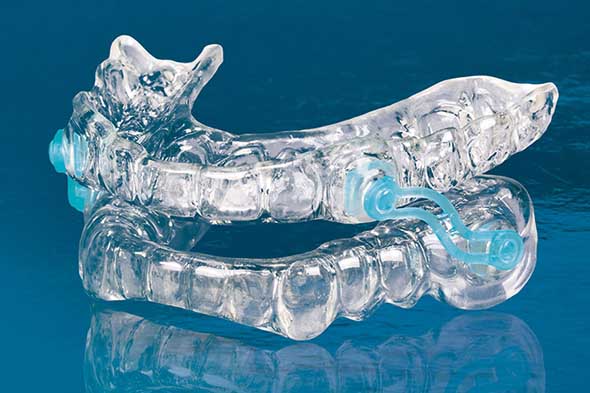Sleep Apnoea & Snoring Appliances Adelaide
If you have been recommended a Mandibular Advancement Splint by a sleep physician or your GP then please contact the team to discuss having a device constructed.
After a thorough examination of your mouth to ensure your suitability a splint can be custom fitted to help reduce snoring, or help manage sleep apnoea.
Quick Description
MADs are worn in the mouth during sleep to hold the mandible and tongue forward and therefore maintain upper airway patency.
The device fits over the upper and lower teeth and creates forward placement of the lower jaw by approximately 8–10 mm (so the lower teeth end up in front of the upper teeth). Ideally, patients should have a follow-up sleep study to see if the device is working.

Tips & Challenges
IMADs have potential advantages over CPAP (the current first-line therapy for OSA). They are less obtrusive and more portable; they make no noise, are not reliant on a power source, and are often more acceptable to patients and families. However, they are not effective for every patient.
Patient acceptance of MADs is generally high. However, physiological, structural, and individual patient characteristics influence response to MAD therapy. Factors associated with better treatment outcomes include:
- lower OSA severity (i.e. mild to moderate)
- female gender
- younger age
- OSA is less pronounced when the patient sleeps on their side
- a face shape with a slightly receding jaw (retrognathic mandible).
Factors associated with poorer efficacy of MADs include:
- older age • obesity and greater neck circumference
- increased nasal resistance
- a very stiff jaw (which impedes advancement)
- dental conditions (e.g. TMJ disease, periodontal disease, insufficient dentition to hold the device in the mouth). Assessment for suitability may require assessment by a sleep specialist (and include a sleep study) or a dentist.
The best place to store your snore guard is in the case that is supplied. This will ensure that it will retain its shape and prevent accidental damage.
Snore guards reduce snoring by bringing your lower jaw forward to open your airway to breathe easier at night.
This not only helps you breathe smoother but also helps with oxygen intake and better sleep.
Not only that it also helps to give your partner a better night’s sleep.
Typically, the adjustment period can take anywhere from 5 to 7 nights. It is perfectly normal for your jaw, teeth & gums to feel sore at first as it is something foreign into your mouth. Very similar to getting braces or wearing a plate/retainer.
The time frame is dependent on the individual so it may take a few more days or a few less. But it gives you a guide.
The benefits of a good night’s sleep and waking up feeling fresh can begin immediately. But it will depend on how long it takes you to get used to the device, which as mentioned can be 5 to 7 days.
But you will notice the difference early on.
